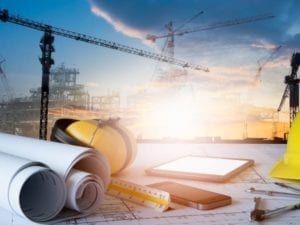Though the mining and power sectors tend to take up much of the spotlight around carbon emission reduction strategies in Africa, construction sectors must not be overlooked in the drive towards achieving Net-Zero.
WSP in Africa Property & Buildings experts share their insights on how the construction sectors in Africa can contribute to achieving Net Zero, even taking into account local nuance for socio-economic needs. Michelle Jackson, Managing Director: Property & Buildings, WSP in Africa, says: “With heavy dependence on fossil fuel-based power generation, high unemployment rates and the critical importance of the mining, manufacturing and other industrial sectors to both employment opportunities and GDP/economic contribution overall, some might argue that we have more pressing issues to worry about in local markets. However, we disagree with that.” Jackson highlights that the transition to a low-emissions society can create opportunities to address the socio-economic challenges faced in many markets across Africa. “For example, we know that addressing the ageing building stock, and ensuring green building principles are applied to new developments, is a key area in terms of cutting emissions. By leveraging energy retrofits and applying green and efficient energy designs to new builds, we can rapidly create easily accessible jobs, cut emissions and provide more liveable cities and spaces.” Construction of buildings and infrastructure accounts for approximately 7 Gt CO2e, or 20% of global carbon emissions, where 4 Gt CO2e is associated with the materials used for construction. When the operational phase of buildings and infrastructure is included, the share of global emissions increases to around 70%, including energy production and use, traffic etc. In developing countries across Africa, rapid urbanisation continues to drive increased demand for infrastructure development to meet the needs of growing urban populations and ensure access to basic services – water, electricity, public transport and others. It is therefore imperative that urban development in Africa be planned and executed with sustainability principles in mind, and that new approaches, alternative lower carbon energy sources and materials be used to ensure Net Zero outcomes. Alison Groves, Regional Director, WSP in Africa, agrees and states: “Including climate perspectives at strategic planning level is critical for African countries to develop sustainably.” Groves indicates that this can be achieved through a few vital steps. Firstly, in practical terms governments and municipalities must work with reliable professional partners to analyse the planned development through a low-carbon lens and evaluate which new urban or infrastructure development will create the most benefits while limiting carbon emissions from power supplies, construction material, construction work and long-time operation and maintenance. Secondly, tapping into alternative and lower carbon power supplies that are increasingly becoming more affordable should be a priority for retrofits and new builds. Renewable energy sources, including for example rooftop solar PV and hybrid power solutions for onsite generation and consumption are often factored into sustainable building designs. Additionally, replacing carbon-intensive construction materials with low carbon alternatives can play a key role in reducing the construction industry’s overall carbon emissions contributions. Steel can be replaced with fibre-reinforced plastic or polymers, or even carbon fibre and graphene, under the right circumstances. African countries need to develop and implement standard codes for the use of alternates like these to steel re-bar to ensure these substitutes are used safely and effectively.Groves points out that Pulverised Fuel Ash, Ground Granulated Blast-Furnace Slag and Silica Fume are already used regularly in cement replacement blends, while traditional asphalt can be replaced with more environmentally friendly natural and synthetic polymers, recycled plastics or even rubber from recycled tyres.
“Bio-based asphalt is a promising solution to reduce emissions and is being tested in Europe. And there are other innovations being tested internationally, such as hydrogen-based steel-making and electrifying the cement making process to reduce emissions,” says Groves. Furthermore, sustainability goals, along with leveraging available technologies, must be considered and integrated into construction projects. This may entail introducing congestion fees for infrastructure and could also lead to the transport and construction of new buildings being constrained according to sustainability objectives. At the same time, more effective use of existing assets can be enabled through automation and digitisation to reduce the need for transport and to optimise the transport that can’t be avoided. “The use of digital technologies allows for many efficiencies to be introduced into the whole lifecycle of built projects – from standalone buildings to mixed-use developments and larger precincts, as well as the surrounding and ancillary infrastructure – from planning through construction, to operation and maintenance,” says Groves. Jackson indicates that WSP utilises the digital twins process to ensure the physical infrastructure matches the digital models. “When advanced technologies are incorporated from the planning and design stages, digital methods reduce the cost and time for delivery, not to mention the savings over traditional design production. The same digital design models can be used during construction to enable the use of mechanisation and robotic fabrication methods. This creates production and resource utilisation efficiencies throughout the lifecycle of the project, which in turn reduces the carbon footprint,” adds Jackson. “Engineering and sustainability professionals in Africa should monitor these kinds of initiatives closely to determine their viability for local application,” says Jackson. “Though, even with careful planning, adopting digital methods and making more climate conscious materials choices, the global consensus is that full decarbonisation of construction projects is not technically possible presently, nor in the near-term.” In the long-term, carbon capture and storage (CCS) may be able to capture and store the remaining emissions. Full-scale CCS is the process of capturing CO2, transporting it to a storage site and depositing it so it will not enter the atmosphere. CCS applied to a modern conventional power plant, or a cement factory, for example, could reduce CO2 emissions by approximately 80–90% compared to a plant or factory without CCS. Each of the three vital elements of CCS – capture, transportation and storage – is proven to be technically possible. What’s been missing is how these could be integrated into the supply chain to benefit all parties. As it stands, the question is who should take the risks, and how to allocate the costs, associated with CCS. But without it, the construction industry cannot achieve true Net Zero within our current realities. CCS is also strongly reliant on predictable and robust legislation, not only in-country but internationally, as construction value chains often cross over national borders. Nonetheless, it does highlight that there is hope for the construction industry to make greater progress towards Net Zero. “Supporting our clients in reducing their emissions remains a primary objective of our work, along with environmental reasons and to promote positive social impact. We believe that employing our Future Ready® approach throughout our project delivery process has the potential to make a significant contribution to decarbonisation of build projects, and with it, do our part to help mitigate climate change,” concludes Jackson.







